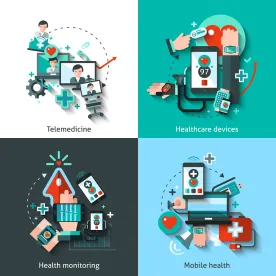Summary
The FDA recently released “Software as a Medical Device (SAMD): Clinical Evaluation,” a final guidance document that aims to establish a common understanding of clinical evaluation and principles for demonstrating the safety, effectiveness and performance of Software as a Medical Device. Rather than replace or conflict with existing regulatory requirements or provide recommendations for application to specific situations, the guidance provides an evidentiary and technical framework to evaluate safety and performance of SaMDs throughout the product’s lifecycle.
In Depth
On December 7, 2017, the US Food and Drug Administration (FDA) released a final “Software as a Medical Device (SAMD): Clinical Evaluation” guidance document (Guidance). The goal of the final Guidance is to establish a common understanding of clinical evaluation and principles for demonstrating the safety, effectiveness and performance of SaMD. As with previously issued SaMD guidance documents, the Guidance is not intended to replace or conflict with existing premarket or postmarket regulatory requirements related to the regulatory classification of medical devices, and it does not provide recommendations for application to specific regulatory situations. Rather, the Guidance provides an evidentiary and technical framework to evaluate safety and performance of SaMDs throughout the product’s lifecycle. It incorporates established quality management principles that developers should consider in the development and design of medical software. FDA intends to consider the principles set forth in the Guidance in the development of its regulatory approaches for digital health technologies through public processes. SaMD software uses an algorithm that operates on data input to produce an output intended for medical purposes, such as to treat, diagnose, drive clinical management, or inform clinical management. Mobile applications that meet this definition are considered SaMD. These products include many functions that are regulated by FDA as medical devices.
The Guidance is intended to build on the previous three SaMD guidance documents: “Software as a Medical Device (SaMD): Key Definitions,” “Software as a Medical Device: Possible Framework for Risk Categorization and Corresponding Considerations” and “Software as a Medical Device (SaMD): Application of Quality Management System,” all issued by the International Medical Device Regulators Forum (IMDRF). The IMDRF is a voluntary group of medical device regulators from Australia, Brazil, Canada, China, Japan, Russia, Singapore, the United States and European countries. The group provides harmonized principles for individual jurisdictions to adopt based on their own regulatory framework. Collectively, the previous IMDRF SaMD guidance documents and the clinical evaluation Guidance provide a framework for defining which functions are considered SaMD, identifying and characterizing risks associated with SaMD functions, developing quality management systems (QMS) and controls for SaMDs, and validating the clinical effectiveness and safety of SaMDs.
As we summarized in our FDA 2016 Year in Review report, FDA released a draft of the Guidance in October 2016. The final Guidance provides further detailed instruction to manufacturers but does not represent a departure from the October 2016 draft.
SaMDs are categorized on the basis of the state of the health care situation or condition in which it is used (critical, serious or non-serious) and the intended medical purpose of the information provided by the SaMD (treat or diagnose, drive clinical management or inform clinical management). The four categories (I, II, III and IV) are based on the levels of impact the SaMD has on patient or public health. The categories are in relative significance to each other. Category IV has the highest level of impact, Category I the lowest. SaMD output used to treat or diagnose a critical health care situation or condition is the highest categorization (IV). Below is the risk categorization framework in the IMDRF SaMD “Possible Framework for Risk Categorization and Corresponding Considerations” guidance. This framework is not intended to supersede FDA’s framework for medical device classifications but, rather it is intended to provide a framework for determining what type and how much data will be required to validate the performance of the device.
|
State of Health care Situation or Condition |
Significance of information provided by SaMD to the healthcare decision |
||
|
Treat or Diagnose |
Drive Clinical Management |
Inform Clinical Management |
|
|
Critical |
IV |
III |
II |
|
Serious |
III |
II |
I |
|
Non-Serious |
II |
I |
I |
The Guidance emphasizes the importance of independent review, i.e., review conducted by outside experts such as formal consultation with regulators, third parties on behalf of regulators, the editorial board of a peer-reviewed journal or “non-conflicted” internal expert reviewers without significant involvement in the development of the SaMD, particularly for SaMDs categorized as III or IV.
The Guidance describes clinical evaluation as an ongoing lifecycle process that involves a set of activities conducted in the assessment and analysis of a SaMD’s clinical safety, effectiveness and performance as intended by the manufacturer. Monitoring real world performance data can help SaMD functionality and intended use evolve after initial introduction into the market. The reference to the use of real world data for performance validation reflects the growing importance of real world evidence (RWE) and real world data (RWD) for product development. See Use of Real-World Evidence to Support Regulatory Decision-Making for Medical Devices (Aug. 31, 2017). The Guidance focuses on three key principles for clinical evaluation:
-
Valid Clinical Association: whether there is a valid clinical association (i.e., scientific validity) between the SaMD output and its targeted clinical condition in the real world through existing evidence (e.g., literature searches, clinical research, professional society guidelines) or by generating new evidence (e.g., secondary data analysis, clinical trials). In other words, Clinical Association demonstrates the level of clinical acceptance and how much meaning and confidence can be assigned to the clinical significance of the SaMD’s output in the intended health care situation and the clinical condition or psychological state (i.e., well-established or novel).
-
Analytical Validation: whether the SaMD correctly processes input data to generate accurate, reliable and precise output data (i.e., confirms and provides objective evidence that the software was correctly constructed through display of accuracy, repeatability and reproducibility and demonstrates the software meets its specifications that conform to user needs and intended uses) through verification and validation activities as part of quality management system (QMS) or by generating new evidence (e.g., curated databases, previously collected patient data). In other words, Analytical Validation is intended to confirm whether the software was correctly constructed.
-
Clinical Validation: whether use of SaMD’s accurate, reliable and precise output data achieves its intended purpose in the target population in the context of clinical care, i.e., yields a clinically meaningful output. Clinically meaningful means a positive impact on the health of an individual or population, to be specified as meaningful, measurable, patient-relevant clinical outcome(s), including outcome(s) related to the function of the SaMD (e.g., diagnosis, treatment, prediction of risk, prediction of treatment response), or a positive impact on individual or public health. In other words, Clinical Validation shows the relationship between the verification and validation results of the SaMD algorithm and clinical conditions of interest as part of QMS or good software engineering practices or by generating new evidence (e.g., clinical data).
If the foregoing cannot be established, the manufacturer must modify the SaMD’s intended use such that it can be supported by available evidence, modify the target clinical association and/or make changes to the software.
On the same day that this Guidance was issued, FDA published draft guidance on clinical decision support software and made technical corrections to existing medical software policies. We describe both guidance documents in detail here. Taken together, the guidance statements clarify how developers should approach the development and classification of software-based medical device products in preparation for pre and postmarket decision-making. In the absence of specific guidance on the implementation of FDA’s Medical Device Quality System Regulation (QSR) for digital health products and software-based medical devices, this guidance and the previously issued IMDRF Guidance documents provide a useful framework for designing, testing and validating medical software.






 />i
/>i

